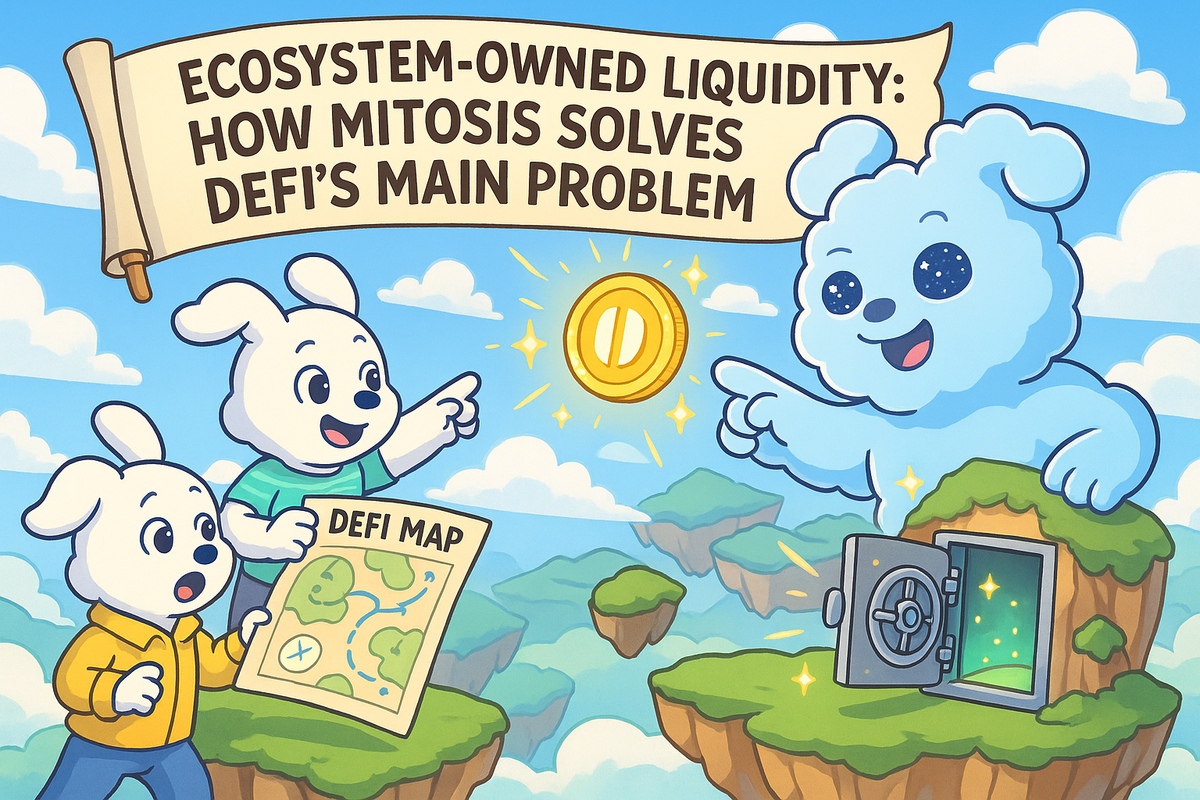Ecosystem-Owned Liquidity: How Mitosis Solves DeFi's Main Problem

Imagine providing liquidity to a DeFi protocol, only to discover a month later that rewards have dried up, users have left, and your funds are trapped in an empty pool. Sound familiar? This is exactly the problem that Ecosystem-Owned Liquidity (EOL) concept solves, as implemented by the Mitosis protocol.
I've studied how this technology works and I'm ready to explain in simple terms — what it is, why it's needed, and how to use it in practice.
What is Ecosystem-Owned Liquidity and Why It Matters
Traditional DeFi works like this: a protocol launches a liquidity mining program, distributes tokens for providing funds, attracts users. But once rewards end — liquidity flows to competitors1.
Ecosystem-owned liquidity flips this model. Instead of renting liquidity from external providers, the protocol becomes its owner. Mitosis implements this concept through special vaults where users deposit assets and receive derivative tokens — miAssets in return.
When I deposit ETH into Mitosis vault, I receive meETH at a 1:1 ratio. These tokens don't just sit idle — they actively work in the ecosystem, generating yield through staking, lending, and participating in liquidity pools.
How the Asset Management System Works
Mitosis uses two main liquidity management mechanisms:
Ecosystem-Owned Liquidity (EOL) — represented by miAssets. These tokens grant the right to participate in protocol governance and influence liquidity distribution.
Matrix Liquidity Framework — represented by maAssets. This features a time-based reward system for long-term liquidity providers.
The key difference from regular farming — if I decide to withdraw funds early from Matrix, I lose accumulated rewards. They get redistributed among those who stayed. This incentivizes long-term participation.
Multi-Chain Efficiency in Practice
One of DeFi's main problems is liquidity fragmentation across different blockchains. I have funds on Ethereum, but the best opportunities are on Arbitrum. Usually, I'd have to make expensive transfers between networks.
Mitosis solves this through integration with partners like Ether.fi, Symbiotic, and Hyperlane. My miAssets can work simultaneously across multiple networks, while the protocol automatically finds the best earning opportunities.
The system works as a unified liquidity pool distributed across 9 blockchains. This increases capital efficiency — instead of keeping funds in one network, they're actively used where demand is highest.
Practical Benefits for Users
In three months of operation, Mitosis attracted over $80 million in total value locked. This demonstrates real demand for such a model.
Main benefits I see:
Yield stability — doesn't depend on short-term incentive programs. The protocol manages liquidity itself and ensures sustainable rewards1.
Process simplification — no need to constantly search for new farms and move funds around. One deposit works in multiple directions.
Risk reduction — ecosystem liquidity is less volatile than external liquidity. The protocol is interested in long-term stability1.
Governance participation — miAsset holders influence liquidity distribution decisions through DAO.
How to Get Started
The process is quite simple. I go to the Mitosis platform, choose an asset to deposit (5 assets available), deposit funds into the vault, and receive corresponding miAssets.
These tokens can be used in other DeFi applications within the ecosystem or simply held to accumulate rewards. The Matrix system offers additional opportunities for those ready to lock funds for a specific period.
Mitosis also launched the Expedition Campaign, where MITO Points are earned for holding miAssets. These points will likely be considered in the future $MITO governance token airdrop.
Development Prospects
Ecosystem-owned liquidity isn't just a new trend, but a logical evolution of DeFi. Traditional mining programs have shown their unsustainability, and protocols are seeking ways to create a stable liquidity base.
Mitosis is in active development — vaults are already operational, while the Layer 1 public testnet is still preparing for launch. The team raised $7 million in investment and continues expanding their partner network.
This approach could become the standard for new DeFi protocols, especially in multi-chain environments where efficient liquidity management is critical for success.
🔗 Stay Connected with Mitosis:
- Explore the project: mitosis.org
- Follow for updates: X (formerly Twitter)
- Join the community: Discord Server
- Get announcements first: Telegram Channel

Comments ()